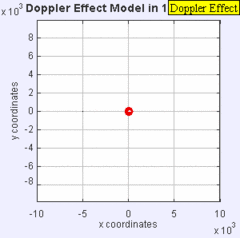In this atom, we are going to cover the Doppler effect , but specifically when the observer is the one in motion.
When the observer moves toward an sound source, each successive wave is encountered sooner than the previous wave. Thus, it will take just a little less time for the observer to hear the next one. Since the time between waves is reduced, the frequency is increased. Similarly if the observer is moving away from the sound source, the frequency, and therefor pitch, is decreased. While the frequency will change whether the observer or sound source is moving, it is easier to show with the sound source as the one moving. This figure demonstrated the sound source moving:

The Doppler Effect
The same sound source is radiating sound waves at a constant frequency in the same medium. However, now the sound source is moving to the right with a speed υs = 0.7 c (Mach 0.7). The wave-fronts are produced with the same frequency as before. However, since the source is moving, the centre of each new wavefront is now slightly displaced to the right. As a result, the wave-fronts begin to bunch up on the right side (in front of) and spread further apart on the left side (behind) of the source.
Unless the observer is moving directly towards the sound source, this angle needs to be taken into account when calculating the newly perceived frequency. Before we can start this calculation, we must know:
- The original sound wave frequency, f0
- The velocity of the observer, vr
- The speed of sound in the air, or medium, c
- The angle of the line of sight from the observer to the sound source,
$\theta$
Although the sound waves are being emitted from the sound source at a uniform frequency, the observer is perceiving them differently. The equation for the perceived wave frequency is as follows: